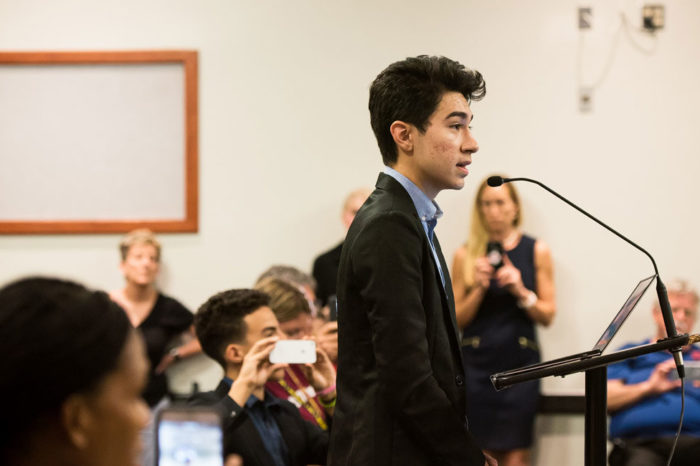Have you ever wondered if technology improves learning? Educational technology supporters and researchers tout the amazing benefits of incorporating technology in the classroom. Those who are on the fence about how useful technology is in the modern classroom provide several counterarguments that warrant further discussion about how to find a happy medium between using technology and traditional teaching strategies.
Technology has its place. The trick is using it to enhance learning instead of doing the same thing in a different way. This article presents a balanced perspective on the advantages of using technology in the classroom. Each benefit provides actionable tips you can use to put on your technology A-game in your classroom.
Creates a Better Learning Environment

Think about your primary to tertiary level learning experiences. You probably were educated in an era when technology wasn’t as ubiquitous and the chalk-and-talk approach to teaching was all teachers knew. Ah, the good ol’ days when you were fighting the urge to sleep every five minutes.
Educase indicates that the world has so drastically changed that Maslow’s hierarchy of needs has been updated to include access to Wifi as a fundamental human need. The 21st century student desires to be connected with the world. Finding ways to help your students create this connection in the classroom is necessary. A study conducted by Justin Tosco, a Masters student at Saint Catherine University, shows that students prefer lessons that use technology.
Effectively engaging your students throughout a lesson helps you win half the battle of getting them to learn the content. In fact, a classroom environment that promotes learning engages students by:
- Encouraging them to ask meaningful questions
- Helping them develop the ability to solve real problems
- Promoting an environment of inclusion where each learner’s needs are met and each learner’s thoughts are valued
- Using a variety of learning models
- Providing them with assessments that are done to promote learning instead of meet administrative requirements
- Having clear standards for excellence
It is true that such an environment can be created without technology. Some teachers have no choice but to find ways to do this because technological resources are limited. This articleemphasises the numerous benefits technology offers to rural school but also discusses the limitations access to technology poses on teachers and students.
Nevertheless, innovative teachers find ways to use technology to create a vibrant learning environment. Two such strategies are described below.
How To Create a Vibrant Learning Environment
- Appeal to a Variety of Modalities
A home theatre projector is a worthwhile investment that either a teacher or school administrator can make for a classroom. Projectors allow you to add audio-visual stimuli to a lesson, even if there is no Wifi access at your school. A study conducted by Rasul, Bukhsh and Batool showed that audio-visual aids make the teaching and learning process more effective.
A variety of apps are available that have audio-visual and kinesthetic elements. For instance, graphs are a common problem for high school students. You can encourage your school’s administration to purchase a class set of graphing calculators if your school is in an area with limited or no internet access. However, if your school is in an area that has internet access and digital tablets, you can consider incorporating the Free Calculator-Pocket CAS lite app in your lessons.
You can also recommend that parents purchase an Osmo Pro Genius Kit for their children. This kit allows children to extend their learning outside of class in a practical way.This review explains how the kit can be used to create tangrams, help children learn new words and develop Physics skills.
2. Develop Problem Solving Skills
One of the arguments against the use of technology in the classroom is that it perpetuates a growing problem amongst generation Y and Z students. They spend so many hours engaging with devices that they lose the ability to think critically and develop motor and social skills.
You, therefore, have a responsibility to ensure that the technological tools you use are meaningful. All technology used in your lesson should help students develop essential skills such as problem solving and team work. They shouldn’t be mindless activities.
Epistemic games offer a solution to this problem. These games essentially help players model real-world skills required to excel in particular professions. A plethora of epistemic games can be found here.
Improves Knowledge Retention

You think you’ve done a good job comprehensively explaining a concept to your students. They’re answering the questions correctly in class and, therefore, should be ready for a test. However, after administering the test you discover that something went terribly wrong.
Students’ poor performance is closely linked to their ability to retain information. A study conducted by Kamuche and Ledman showed a non-linear relationship between length of time and knowledge retention. Their study explained that the amount that was initially learned plays the most important role in long-term retention.
Technology in the classroom can facilitate an increase in the amount of information retained. However, this can only be effectively accomplished when you carefully plan how technology will be incorporated in your lesson.
Teachers have experienced vast improvements in their students’ performances when they incorporate technology in their lessons. One of the most profound success stories is that of the engineering-technology program at Rochester Institute of Technology.
A study was conducted over a 6 year period. The focus was identifying how to decrease the amount of students who either failed or left the engineering-technology program. Lecturers began using multiple types of technology, such as tablets, collaborative software, and projection screens. The result was an improvement of the retention rate to 71 percent. Students indicated that this success resulted from them being able to retain more information using the technology available.
Another study conducted by Justin Tusco ina Montessori elementary classroom showed a 16 percent increase in test scores when technology was used in instruction. Both sets of results provide substantial evidence in support of the use of technology in the classroom.
How To Promote Knowledge Retention
- Utilize the Features of Blended Learning
Blended learning merges the best of both worlds. It combines the benefits of technology with face-to-face instruction. Technology should be used to enhance traditional instruction, not replace it. As futureready.org puts it, “Blended learning models intentionally integrate technology to boost learning and leverage talent; they don’t just layer technology on top of business as usual.”
Key features of blended learning are listed below:
- Students must be given some control over the content and instruction. This control includes monitoring the pace and timing of instruction. Think of it like an e-learning course on Udemy
- The online and face-to-face components must work in harmony. They must connect in a way that makes sense
- The technology used should adapt to each students’ abilities and unique needs
- The ability to record and report student data. You must be able to track the progress of each student.
- Appropriate follow-up actions should be recommended based on the data received
- Online results should be used to inform in-class instruction
2. Use Games to Increase Practice
Consistent practice outside the classroom is important. Many students don’t develop the intrinsic motivation needed to get additional practice and support. For them, it’s more exciting to find ways to have fun.
Feed that excitement by introducing your students to gamification.Top Hat explains four interesting ways to include gamification in your instruction.
Encourages Individual Learning

Teaching for the average student is easier than differentiating instruction. A one-size-fits-all strategy, however, can’t work when your classroom is filled with diverse learners. Some students are slower than others, some process information quicker than others, and some fall somewhere in between.
Differentiated instruction is a useful concept in theory. You would ideally love to create a personalized learning plan for each student. The demands placed on you, however, often make it impossible for you to plan such ideal lessons all the time.
Technology provides solutions that make planning differentiated lessons easier. Activities can be created to match each learner’s unique needs and pace. This is particularly evident in the Math classroom where consistent practice is necessary for mastery. As Kelly Tenkley, a technology teacher, states technology enables struggling students to interact with material suitable for their level and progress at their own pace.
How to Plan a Differentiated Technology Lesson
- Differentiate the content.
You can plan tiered lessons. In tiered lessons, learners are divided into 3 groups: upper, middle and lower. The content of the lesson can be adjusted to suit each level of students. Upper-tiered students can handle more advanced content than lower-tiered students. Students can be provided with the opportunity to move from one tier to the other once they have mastered the content of their current tier.
- Differentiate the process
The upper-tiered group can work collaboratively on higher-ended tasks related to the content. The middle-tiered group can use videos from websites such as Moby Max, Khan Academy and IXL to guide their activities. The lower-tiered group can receive individual attention from you supported by technology games and resources.
3. Differentiate the product.
Upper-tiered students can be challenged to create presentations using websites such as Prezi, Powtoon and EduBlogs. After you’ve vetted these presentations, these students can be asked to use their presentations to teach the class. Lower-tiered students can use collaborative tools, such as Google Docs, to share what they learned from the presentations.
Students in each group can also prepare written work for presentation. This written work can be projected for the class to view during the presentation using a document camera. This article highlights some of the best document cameras for your classroom.
Project-based learning can also be differentiated. The students can be placed in homogenous groups and asked to choose a topic. Each group would use some type of technology to make their presentations. For instance, you could provide each group with a camcorder to create a music video depicting the topic. A discussion can be facilitated at the end of each presentation to see how much the students have learned.
4. Provide resources that can be used outside the classroom.
Students should be provided with additional resources that they can access outside of the classroom. This is what truly allows them to work at their own pace. Make videos and practice assignments available to students outside the classroom.
Encourages Collaboration

Students must be provided with opportunities to work together.Working in isolation isn’t the way the world works. Collaborative learning is student-centered and allows students to work together to solve real-world problems.
Carefully planned collaborative instruction allows students to develop crucial skills. These skills include:
- Critical-thinking
- Self-management
- Leadership
- Learning to work with diverse people
Collaborative learning isn’t merely placing students in groups and giving them practice questions to complete. It is a discussion-rich environment that challenges students to think outside the box. Focusing on recall and lower-level tasks has no place in the collaborative learning environment.
How To Use Technology in Collaborative Learning
- Connect with classrooms around the world
Technology allows teachers around the world to provide opportunities for their students to collaborate on projects. Rockingham Middle School in North Carolina collaborated with a classroom in Sweden on a science project. The collaboration made the project more interesting since students were able to share their results and learn more about each other.
2. Create a Google Classroom
Google classroom allows you to create a collaborative online environment for your students. There are over 50 apps that integrate with Google classroom. You can use a combination of apps that meet the unique needs of your students.
3. Utilize other online learning platforms and digital tools
Other online learning platforms and digital tools also exist. Each platform offers various combinations of features that you can adapt to suit your classroom. Some of these platforms and digital tools include:
- Blackboard Collaborate
- Learn Boost
- Moodle
- Class Dojo
- Pixton
- Voice Thread
- Socrative
- Engrade
- Top Hat
- Trello
- Kahoot
- ReadWriteThink
Creates a System for Managing Learning (a LMS)

A Learning Management System (LMS) is an internet-based software application that allows users to create eLearning courses, monitor these courses, track students’ progress, and provide relevant student-related reports. A LMS is used in a variety of industries to make training more accessible.Some of the software previously mentioned, such as Moodle, are examples of LMSs.
Tertiary-level institutions in particular depend heavily on a LMS for course delivery. The University of Buffalo indicates that approximately 99 percent of tertiary-level institutions use a LMS. Such prominent use of the software can be attributed to the following benefits:
- The ability to access content anywhere, anytime
- Reliable tools for monitoring student progress
- Closer monitoring of assignment submission
- The creation of a communication pathway between teachers and students
One of the strongest benefits of a LMS is the ability for students to collaborate. However, Steven Lonn, in his research on the use of a LMS for collaboration and knowledge construction, discovered that although the students effectively interacted using the system, there was little knowledge construction. Therefore, you must be very deliberate about helping students acquire new knowledge through critical thinking if you plan to use a LMS.
How to Use a LMS to Develop Critical Thinking
- Create student-centered activities
Student-centered teaching is commonly discussed amongst educators. Teachers are often encouraged to become facilitators of learning instead of deliverers of content. The reality, however, is that it’s often difficult to create such an environment.
A question that may be running through your mind is, “How can I ensure that all my students learn the correct concepts if I’m not telling them what to do?” A well-planned lesson that allows you to ask the right questions that guide learning, and effectively incorporates a LMS, is the answer.
Remember that you’re using blended learning as previously discussed. Consequently, there’ll be elements of your lesson that use technology and others that don’t. Both instructional media should incorporate opportunities for collaborative learning, research, and informal assessments.
Collaborative learning helps students learn from enriched discussions. A LMS typically provides opportunities to create group forums and allows participants to leave comments on other’s posts. Some LMSs also allow users to collaborate on documents. Pose the right discussion questions and allow your students to collaborate to find the answers.
Independent research is important for self-paced learning. The video tutorials and material you create for your LMS should encourage students to do further research. It is through extending their learning that they will make the necessary connections to learn new concepts.
Students dread assessments. Watch the reactions on your students’ faces the next time you tell them that they have a graded assessment to complete. A LMS allows you to create fun, interactive informal assessments that students will appreciate. These assessments also help both you and your students have a clear picture of what has been learned.
Prepares Students for the Future

The world has changed. Traditional jobs are gradually becoming obsolete as technology gains prominence. The World Economic Forum states that about 65 percent of primary-school aged children will eventually get jobs that don’t exist today. They further state that there will be about 1.5 million new technology-related jobs by 2020.
Students must be prepared to meet the demands of this changing world. Consequently, the way students are taught must help them develop the skills needed to meet the demands of the IT world.
Technology is improving at a faster rate than our education system. Improvements have been made to the education system over the past decade, but students still don’t have the requisite skills and knowledge they need to truly succeed in this digital world. Dr. William Daggett states supports this point by saying that “society demands a higher level and different skill sets than schools were ever designed to teach.”
He further highlights that although money has been spent to include technology in the classrooms, many teachers aren’t using it effectively. This points to a lack of training about integrating technology into instruction.
This growing need has encouraged discussions about the characteristics of a future-ready school. Such robust discussions resulted in the creation of the futureready.org website. This website provides a plethora of digital resources to help you plan lessons that prepare your students for the future. The organization also offers micro-courses to train teachers, school administrators and district leaders in strategies for creating a future-ready school framework.
How To Create a Future-Ready School
- Provide ubiquitous access to technology.
Future-ready schools have internet access and technological resources for all students. You won’t be able to create technologically- enriched lessons without access to the right technology.
The benefits of technology highlighted in this article are based on the assumption that all teachers and students have equal access to technology resources. Sadly, this isn’t the case. There is a huge gap between technology access for low and high income communities.A report published by the Stanford Center for Opportunity Policy in Education states that computer ownership, the quality of devices, and internet access is lower for lower-income teens and teens of color than it is for high-income and white teens.
This presents a grave cause for concern since there are more low-income students and students of color in the U.S. education system than there are high-income and white students. Lower-income students often aren’t provided with the quality of technology instruction they need since resources are limited, teachers aren’t adequately trained, and they don’t have access to technology at home. Teachers, school administrators, and other key education stakeholders must find ways to bridge the gap so that these students can experience the enhanced learning experience technology provides.
Adapting technology to suit the context of low income communities is another concern. Michael Trucano, in an article published on the World Bank’s blog, says that “most products, services, usage models, expertise, and research related to ICT use in education come from high-income contexts and environments.” This leads to the conclusion that ICT use in low-income classrooms is useless because the results achieved in high income environments aren’t the same in the more challenging, low-income environments.
These points emphasise the need for careful consideration about the integration of technology in low-income communities and classrooms. Educators and policy-makers must pay attention to the type of technology being implemented and how accessible it is to all stakeholders.
2. Provide training to both school leaders and teachers.
People can’t be thrown into the deep without learning to swim. Dr. Tim Ham cites a source in this article that states that any program that prepares school leaders and teachers to embrace technology in education “should be an adaptive and open system which is dynamic, differentiated and a continued renewal process that leads to continuous learning.” Technology will always be advancing. Training programs must, therefore, offer continuous learning opportunities.
An approach that school districts can use to train teachers is to link technology training with incentives. Madison School District developed 3 types of training initiatives that rewarded teachers with technological resources upon successful completion of each course.
One was differentiated and allowed teachers to choose specific courses that met their teaching needs. The other involved selecting a teacher from each school in the district to be trained on using technology to improve teacher achievement.This teacher was then charge with using what was learned to train others. The final program included coursework that teachers took at their own pace. Successful completion of the coursework resulted in each teacher being rewarded with a laptop.
The program has received resounding success. Teachers have voluntarily participated and received SmartBoards, document cameras, and response pads for their classrooms. A continuous training program that offers such incentives could be useful for encouraging teachers to willingly participate in training opportunities.
However, it must be noted that creating a classroom transformed by technology doesn’t happen overnight. The Shelby County School District encouraged school leaders to make technology integration a mandatory part of their teacher assessments. They also created a series of training sessions on the effective use of technology. True change didn’t occur until 2 years later.
Helps Teachers Reach Students

Technology helps you reach students outside the classroom. It also helps you appeal to students’ interests. Both elements are important in the teaching and learning process.
Students must view themselves as lifelong learners. They must see learning as an extension of what they do in the classroom, not a separate experience. An article published by the University of Washington states that students have greater autonomy of the learning process when they have access to course material outside of class, do additional reading, watch pre-recorded video lectures, and complete research assignments.
A teacher who gets students excited about learning has won half the battle of having them retain information. You want to be this teacher. Jake Spanberger cites a study in which 70 percent of the students who participated stated that they learn best in a blended learning environment. Fifty percent of the respondents also stated that they are more engaged in classes that use technology.
How to Use Technology to Reach Students
- Plan technology related activities for students to complete outside of class.
Some of the ways technology can be used outside the classroom were mentioned earlier in the article. Some additional strategies that can be used are a webquest, a class webpage, an email exchange, or a class blog.
This article highlights the numerous benefits of WebQuests. A WebQuest is a discovery learning tool that provides students with step-by-step online resources to complete a task. The resources act as the map for the quest. The quest begins with a challenge question related to a real-world problem.
For instance, the students could be given the following scenario, “Mrs. Lilly wants to build a rectangular garden plot that has an area of 120 ft2 . How many tomato seeds can she plant in this plot? How would she have to plant them?” The students will then be taken through a list of online resources that provide information about how to plant tomato seeds and how to create a garden plot. You could then require the students to collaborate and make presentations that demonstrate their findings.
There are several free website creator tools that can be used to create a class website. The most popular tools are WordPress, Wix, and Weebly. The website can be used to feature students’ work and classroom activities, provide access to assignments and syllabuses, and communicate with parents.
An email exchange allows students to see themselves as global citizens, develop email writing skills and interact with other students outside of their school. It’s a modern take on the penpal system of the 90s. The email exchange can be further extended to cross-boundary class projects.
A class blog can be a good tool for helping your students develop their writing skills. It’s also good for extending learning outside the classroom. Two of the most popular classroom blog creators are Kidblog.com and Edublog.com.
2. Provide choices.
Provide students with choices of the technology media to use in the classroom. Larry Ferlazzo states that students can be happier and more willing to learn and accept challenges if they are given choices. Choices can include video creation, animations, 3D printing, creating comics, creating simple apps, online games, app games, or augmented reality. The options you provide depend on the resources available.
Helps Teachers Better Prepare Lessons

Teaching requires constant creativity. It can be extremely difficult and time-consuming to come up with engaging activities to teach concepts. Thankfully, there are numerous online resources available to help you plan creative lessons.
Planning creative lessons isn’t your only task as a teacher. You must become a lifelong learner willing to hone your skills to become the best possible educator. This requires a lot of reading, interaction with other colleagues, and actively pursuing professional development opportunities.
How to Use Technology to Better Prepare Lessons
- Collaborate with other teachers.
Technology provides more than just an opportunity to get sample lesson plans. Teachers can collaborate with other teachers from around the world to get ideas for effectively reaching their students.
2. Keep Up-to-Date With Recent Education Developments
Research is ongoing in the education industry. New developments can help you better tailor your lessons to suit your students. There are also a variety of education conferences held throughout the year that can help you keep current.
Helps School Leaders Keep Track of a School’s Progress

School leaders must carefully monitor the progress of their students. Each district sets annual targets which school leaders must either meet or exceed. Achieving such success is only possible if school leaders effectively communicate these goals and expectations to teachers and consistently monitor students’ progress.
How To Keep Track of Students’ Progress as an Administrator
- Implement and monitor the effective use of a student data system.
A report published by the U.S. Department of Education underscores the importance of data-driven educational decisions. The report states that these decisions center on “a set of expectations and practices around the ongoing examination of student data to ascertain the effectiveness of educational activities and subsequently refine programs and practices to improve outcomes for students.” Therefore, school administrators must not only find the right student data system for their schools. They must also train teachers on how to use the data obtained from this system to improve results.
Effective use of the data obtained from a student data system makes the possibility of no child being left behind a greater reality.
A student data system can only work if:
- teachers regularly upload grades, attendance records, and disciplinary data
- all assessments are meaningful and free of discrepancies
- strategies are implemented to address the challenges identified in the data
Encourage your school’s administrator to make this a reality if it isn’t already happening at your school.
Putting It All Together

Our children are a part of the third industrial revolution. The skills they need to succeed in today’s digital world surpass those you needed for your career. Technology must be effectively implemented in instruction so that all students can develop the skills needed to excel in this new era.
Effective use of technology in the classroom focuses on student-centered learning. Students are active participants who develop the critical thinking skills needed to solve real-world problems. It’s more than just piquing their interest.
As an educator, it’s important for you to embrace blended instruction. Technology and teacher facilitated instruction must come together in your classroom. You can only make this happen if you:
- Take the time to deliberately plan your lessons
- Plan activities that provide students with the appropriate challenge
- Provide opportunities for students to collaborate
- Use technology for individual learning
- Differentiate instruction
- Encourage and guide students through the use of various technology media.
The task seems challenging, but the results are ultimately worth every ounce of effort.
 Salaries lag in some states, but nationally, wages and benefits outpace the private sector.
Salaries lag in some states, but nationally, wages and benefits outpace the private sector.


























